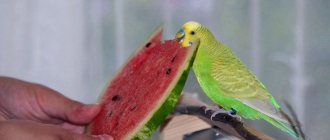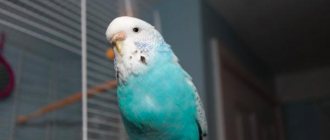Common reasons why a bird flies away
In most cases, the parrot flies away by pure chance when the owner forgets to close the window or door, letting the pet fly around the room. The person doesn’t even have time to react, the bird flies out into the street so quickly.
These nimble creatures can flutter out of a slightly open door when you leave for work or let guests into your home. Moreover, you may not immediately notice the disappearance of your pet.
You will be lucky if the parrot flies into the entrance - this way you have a better chance of quickly finding it and returning it home. It’s a completely different matter when a pet flies into the street from a private house.
Attention! You cannot catch a flying pet with your hands or frighten it with sudden movements. A disoriented bird in panic may fly away from you and you will never find it again.
Often, fugitives themselves do not understand where they are flying and why. The problem is that they do not have the instinct for self-survival, unlike their wild relatives. The world greets them rather unkindly: cold, hunger, attacks by wild birds, dogs, cats. The bird is disoriented in an unfamiliar space and is in shock.
If you get a parrot, there is always a risk that it will fly out the window, even if it is sitting in a cage. The door of the home may not be closed correctly and the bird will get out. Many birds are smart enough to get the hang of it and open a not very secure lock on their own. If you have a dog or cat at home, they may knock the cage onto the floor and the bird will escape. Therefore, keep your windows closed or install strong mosquito nets on them.
How long can a parrot live outside?
Every owner of a winged pet that has flown away is interested in the question of whether it can survive in nature. And most importantly, how long a bird can live without its usual conditions.
If a cockatoo, cockatiel, budgerigar or red-tailed gray flew out from their “native home” in the summer or autumn, when there are no problems finding food, then they will be able to adapt to new conditions quite quickly and will most likely remain alive until the onset of cold weather. However, the winter drop in temperature will be a real test for birds. Frostbite and hunger are certain death for them.
It is worth not forgetting about the worst enemies of parrots on the street:
- owls;.
- hawks;
- cats;
- dogs.
We invite you to find out how cats and parrots get along in the same apartment.
Moving cars are also dangerous for winged pets. From the above it follows that every effort must be made to find the flown away parrot and return it home. Experts believe that exotic birds outdoors cannot always adapt because they are unable to find food. Therefore, by the third day, the parrot will be hungry, dehydrated and exhausted due to lack of sleep. Birds in this state may respond to the call of strangers. During this period they are easy to catch.
What to do if the parrot flies away
If you see your pet nearby, do not frighten him with sudden movements. Sensing your panic, the bird may also panic and fly away.
When you see a budgerigar fly away, follow its flight path. Most birds that find themselves in an unfamiliar environment try to hide by perching on the nearest tree. Remember how the parrot behaved when it first came into your home after purchase: confused and scared. The same emotions overwhelm him when he realizes that he is lost.
What to do if a parrot flies away without you noticing? You will have to act at random. In any case, most likely the bird did not fly far and took refuge in the foliage of nearby tall trees.
A frightened pet will hide and begin to look around without giving any signs of its presence. He is scared to fly anywhere, and even more scared to go down.
To bring a missing fugitive home, your job is to attract his attention. Moreover, this should be done using what is familiar to him: calling the pet by name, turning on his favorite melody or recording his partner’s chirping, if the parrots lived in pairs.
Methods of attracting attention
- If you have an open balcony, place on it the cage in which the parrot lived and turn on your favorite tune. You can include a recording of birds chirping, the main thing is that it is the singing of birds of its species. Don’t constantly scroll through melodies and sounds, take breaks.
- Display a feeder filled with your parrot's favorite treats.
- On the balcony or near the house (if it is a private house) you can place a cage with another bird that lived in pairs with the fugitive that flew away. She will also beckon her partner with her chirps.
- Go look for him around the area, walk around, call him by name and listen, in case he answers you.
Basic ways to catch a parrot in a room
There are special methods and methods for catching a parrot in a room if it does not want to return. The most reliable and common way is food, which makes it easy to lure your feathered pet into the cage. To do this, the cage house must be positioned so that the parrot can clearly see it and especially the feeder, where it is worth putting his favorite treat. But this method only works if the bird is hungry.
If the parrot is not hungry, then you can catch the parrot using the second method. Usually such feathered pets living at home have a favorite toy. Such a toy should be placed in the cage so that the parrot can see it. Often such a bird can be caught with a new toy, especially a bright one. It is known that parrots not only love everything bright, but are also very curious by nature. It is desirable that such a toy be as colorful and bright as the parrot itself.
The third way to catch a parrot and return it to its cage is to create artificial twilight in the room. Feathered pets, seeing that darkness has fallen in the room, will decide that it is already evening and will return to their cage to fall asleep. Creating such twilight is quite simple: turn off the lights, close the curtains or blinds. Parrots do not see well in the dark, so they will not fly, but safety and habit for them in such a dark time are the main conditions.
What to do if the parrot is not found
Unfortunately, it very often happens that the parrot flies away and the owners never find it. Of course, the bird, feeling hungry and thirsty, tries to find its home, but in an unfamiliar environment this is difficult to do. That’s why birds often fly into other houses and onto balconies.
Post missing pet notices around the area and offer a reward to the finder. There are cases when this worked and the bird returned to its owner.
But it is also not uncommon for a parrot to be lost forever, finding a home with a new owner or dying.
How to catch a parrot in a room
Most owners keep their parrots in a cage. For some species, such as wavy birds and lovebirds, this is the optimal way of keeping them, as long as they have enough space and the birds do not feel cramped. Others, larger ones, need more space and freedom of flight, but pets do not always want to behave as they should. Any owner will benefit from ways to catch a parrot in the room if it has flown out and does not want to return “home”.
What to do to prevent pets from flying away
So that you never encounter a situation where a parrot goes missing, as well as to make it easier to catch and return home, you should consider these recommendations:
- When a pet appears in your house, you should not immediately let it fly around the room, it needs time to adapt, when the pet gets used to you, will readily take food from your hand and sit on it, you will not encounter the difficulty of driving the parrot into a cage after a walk around room;
- When letting your pet fly around the room, always close the doors and windows, or install strong mosquito nets on the window openings, however, make sure that your active pet does not pick them apart and escape into the street;
- when leaving the house or letting guests in, close the room in which the bird is located so that it does not fly out through the open door, or lock it in a cage (aviary);
- teach your parrot to follow the commands “stop” and “come to me” - if your parrot flies away, such training will help bring it back;
- truly make friends with the bird, love it, provide high-quality care and maximum attention so that it gains complete trust in you, this can also help in the return of the pet.
To prevent your parrot from flying away, despite all your precautions, always be on guard. These are very smart birds, capable of taking advantage of the slightest mistake of their owners and breaking free, which they then, however, do not know what to do with.
This is exactly what watch the video about, how parrots fly away even from the most responsible and careful owners:
The most decisive way to catch a parrot
If you cannot catch a feathered pet in a room by other means, then the most radical method should be used. When fishing with your hands, you should not only darken the room, but also take someone as an assistant. The parrot does not fly in the dark and usually lands in a safe place. Therefore, having sneaked up to him, you can command the assistant to turn on the light and take the bird.
When catching a parrot with your hands, you should use gloves so that the bird does not smell the hands and then does not hold a grudge against its owner. When fishing this way, you should always handle the feathered pet carefully and carefully so as not to cause any harm to it. If you do everything carefully and don’t make too much noise, the parrot won’t even understand what happened.
What do you need to take care of in advance?
To reduce the likelihood of a parrot flying out or make it easier to catch, here are some tips:
Close windows and doors when letting your parrot out of its cage to fly. Install metal mosquito nets on the windows, then the windows can be opened, but still watch out, it happens when the parrot picks them apart with its sharp, powerful beak.
The most important thing is to give your ward the proper attention and care. Make sure you become his friend.
When you get a parrot, do not let it out of the cage until it is completely accustomed to you, until it eats from your hand and sits on it.
Once the bird is accustomed, begin teaching the “come” and “stay” commands. They can be of great use.
In the process of keeping parrots, sooner or later, every owner lets his pet fly around the apartment. This is necessary for the bird to “stretch its wings,” change its surroundings, and get closer to its owner. Unfortunately, many parrot owners make mistakes and their pets leave the person’s apartment. Let's consider what to do if the parrot flew away from home?
Corella parrot: description
Corella parrots have become known to lovers of our country quite recently. Despite this fact, these exotic birds are characterized as quite smart, original and low-problem in keeping.
Intelligence
These birds are deservedly included in the top ten most intelligent birds, which makes it possible to keep them in human conditions without any problems. As the experimental results show, the level of intelligence of this bird is comparable to the level of intelligence of a 5-year-old child.
Appearance and colors
Adult birds of this species grow up to 33 cm including the tail. The tail is quite long and pointed, and the head has a rather high crest. At the same time, the plumage of females and males has differences. Males are characterized by the presence of a brighter, defiant olive-gray shade, while the crest and head are distinguished by the presence of a yellow tint. The wings are more colored in velvet-black tones, with the presence of a bluish or silver color.
Interesting fact! The beak of this bird, both in appearance and in shape, is more reminiscent of the beak of a cockatoo, but at the same time does not differ in size, since it is significantly smaller in size. Despite this, the bird's beak is quite powerful and sharp, since the bird is able to bite through wire, such as electrical wiring.
As for the females, they are characterized by a dirty gray coloring of the main plumage, as well as the presence of a brownish tint on the underside of the body, while the cheeks are painted with spots of a pale brown tint. The head and the crest itself are pale gray with the presence of light yellow tones. The fact that young birds are more similar in color to females is considered characteristic. In this regard, only after a year can the gender of the birds be determined.
Subspecies of Corella parrot
Due to the fact that breeding such birds in captivity is simple, as a result of the work of specialists it was possible to obtain various shades of the birds’ plumage, which further complicated the process of determining the sex of the Corella parrot. The most famous subspecies are:
- The albino cockatiel is a bird with white or cream colored plumage with red eyes. This is due to the complete absence of coloring pigment. The head and crest are distinguished by their yellow color. The female may have pale yellow spots on her wings.
- The cockatiel is white with black eyes, the result of crossing a white female and a gray male. Males of this subspecies are distinguished by the presence of white feathers in the tail, while in females this part is marbled.
- The Lutino Corella is a yellow parrot with red eyes. On the sides of the head, regardless of gender, you can see characteristic bright orange spots.
- The cockatiel is light gray with black eyes. The subspecies was created by crossing a gray and a white parrot. The subspecies is distinguished by the presence of light gray shades in the tail.
- The cockatiel is dark yellowish , although there are subspecies with many variations of similar shades, ranging from dark yellowish to light cream.
Recently, the Corella Sheki bird has appeared, which is characterized by the presence of heterogeneous white spots on its plumage. Many experts believe that this subspecies can serve as a good basis for breeding new subspecies that are very original in color.
Interesting to know! The Sheki subspecies has quite interesting color variations: they can be pearl-gray, white-winged and black-winged, including a black-gray shade with a pure black chest.
Corella - All about the parrot species | Parrot species - Corella
Natural habitats
Being in their natural environment, these birds for their livelihoods choose forest plantations located in the coastal zone of reservoirs, as well as eucalyptus groves and thickets of shrubs located in the savannah. Numerous flocks can be seen on the tops of dried trees, as well as on tall bushes. The most numerous populations are observed in Australia.
Precautionary measures
As we wrote above, do not leave your parrot in a room with open windows and doors.
In summer, be sure to install mosquito nets, although there are known situations where extremely curious birds overcame even this obstacle.
Even the most responsible bird owner is not immune to the human factor. Having let the bird fly around the house and closed the windows before doing so, we cannot control all family members. And there may be someone in it who, by chance, opens the window for just a couple of minutes. This will be quite enough for the “escape” of the feathered friend.
If the parrot flies away, under no circumstances should the first reaction be panic. Only by pulling yourself together can you make the right decision and try to bring the fugitive home.











